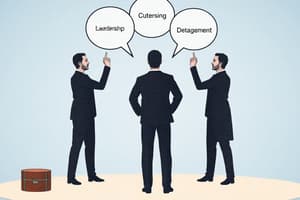Podcast
Questions and Answers
What aspect of motivation refers to the direction of an individual’s behavior?
What aspect of motivation refers to the direction of an individual’s behavior?
- Choice made between alternatives (correct)
- Strength of behavior
- Ability to satisfy individual needs
- Persistence of behavior
Which definition of motivation emphasizes the willingness to exert effort toward organizational goals?
Which definition of motivation emphasizes the willingness to exert effort toward organizational goals?
- Campbell et al.'s definition
- Dale Carnegie's definition
- Berelson and Steiner's definition
- Robbins' definition (correct)
What does Dale Carnegie suggest is essential for influencing others to act?
What does Dale Carnegie suggest is essential for influencing others to act?
- Inspiring intrinsic motivation (correct)
- Coercion and authority
- Financial incentives
- Direct orders and commands
Which factor is NOT part of Campbell et al.'s measures of motivation?
Which factor is NOT part of Campbell et al.'s measures of motivation?
What is a common misconception about motivating technical professionals?
What is a common misconception about motivating technical professionals?
Which component of motivation focuses on the persistence of behavior?
Which component of motivation focuses on the persistence of behavior?
In the context of leadership, what is essential for motivating scientists and engineers?
In the context of leadership, what is essential for motivating scientists and engineers?
Which term describes the inner state that energizes and directs behavior?
Which term describes the inner state that energizes and directs behavior?
What is the significance of motivation in technical leadership?
What is the significance of motivation in technical leadership?
How is motivation characterized by Berelson and Steiner?
How is motivation characterized by Berelson and Steiner?
What is one primary reason that makes it easier to be persuaded by someone?
What is one primary reason that makes it easier to be persuaded by someone?
Which factor contributes to the emergence of informal leaders in group activities?
Which factor contributes to the emergence of informal leaders in group activities?
Which of the following is NOT listed as a component of effective leadership?
Which of the following is NOT listed as a component of effective leadership?
According to Rudy Giuliani, what is essential for a leader to inspire followers?
According to Rudy Giuliani, what is essential for a leader to inspire followers?
What assumption underlies the effectiveness of conducting assessment centers for potential leaders?
What assumption underlies the effectiveness of conducting assessment centers for potential leaders?
What aspect of leadership does the Golden Rule emphasize?
What aspect of leadership does the Golden Rule emphasize?
What is indicated as a crucial quality for leaders in overcoming challenges?
What is indicated as a crucial quality for leaders in overcoming challenges?
What role does effective communication play for a leader, as described in the components of leadership?
What role does effective communication play for a leader, as described in the components of leadership?
What approach should leaders take to create a strong team according to the leadership strategies?
What approach should leaders take to create a strong team according to the leadership strategies?
Which of the following is emphasized as an ongoing process in effective leadership?
Which of the following is emphasized as an ongoing process in effective leadership?
What is the primary distinction between leadership and management?
What is the primary distinction between leadership and management?
According to the content, which statement regarding managers is true?
According to the content, which statement regarding managers is true?
What does Drucker suggest about management?
What does Drucker suggest about management?
Which of the following is NOT a characteristic of formal leaders?
Which of the following is NOT a characteristic of formal leaders?
What is one way people can become leaders?
What is one way people can become leaders?
Which of the following best represents the nature of leadership?
Which of the following best represents the nature of leadership?
What is indicated by Sir William Slim’s definition of leadership?
What is indicated by Sir William Slim’s definition of leadership?
What is a key difference between leaders and managers in their approach to influence?
What is a key difference between leaders and managers in their approach to influence?
Why might organizations face challenges when distinguishing between leadership and management roles?
Why might organizations face challenges when distinguishing between leadership and management roles?
According to the content, what can be said about a leader's influence?
According to the content, what can be said about a leader's influence?
Flashcards
Leadership
Leadership
The ability to influence others to achieve a shared goal.
Management
Management
A formal role with authority to plan, organize, staff, direct, and control.
Leadership vs. Management
Leadership vs. Management
A manager may or may not be an effective leader. Leadership goes beyond formal authority.
Leader's style
Leader's style
Signup and view all the flashcards
Manager's experience
Manager's experience
Signup and view all the flashcards
Leader's background
Leader's background
Signup and view all the flashcards
Formal vs. Effective Leadership
Formal vs. Effective Leadership
Signup and view all the flashcards
Leadership process
Leadership process
Signup and view all the flashcards
Styles of leadership
Styles of leadership
Signup and view all the flashcards
Effective leadership principle
Effective leadership principle
Signup and view all the flashcards
Emergent Leader
Emergent Leader
Signup and view all the flashcards
Expert Power
Expert Power
Signup and view all the flashcards
Referent Power
Referent Power
Signup and view all the flashcards
Formal Leader
Formal Leader
Signup and view all the flashcards
Informal Leader
Informal Leader
Signup and view all the flashcards
Assessment Center
Assessment Center
Signup and view all the flashcards
Set of Beliefs
Set of Beliefs
Signup and view all the flashcards
Optimism
Optimism
Signup and view all the flashcards
Courage
Courage
Signup and view all the flashcards
Relentless Preparation
Relentless Preparation
Signup and view all the flashcards
Motivation
Motivation
Signup and view all the flashcards
Motivation in Organizations
Motivation in Organizations
Signup and view all the flashcards
Motivation's Impact on Behavior
Motivation's Impact on Behavior
Signup and view all the flashcards
Dale Carnegie's Principle of Motivation
Dale Carnegie's Principle of Motivation
Signup and view all the flashcards
Motive (as defined by Berelson and Steiner)
Motive (as defined by Berelson and Steiner)
Signup and view all the flashcards
Motivating and Leading Technical Professionals
Motivating and Leading Technical Professionals
Signup and view all the flashcards
Nature of the Professional
Nature of the Professional
Signup and view all the flashcards
What Motivates Scientists and Engineers
What Motivates Scientists and Engineers
Signup and view all the flashcards
Significance of Motivation in Leading Technical Professionals
Significance of Motivation in Leading Technical Professionals
Signup and view all the flashcards
Effective Leadership of Technical Professionals
Effective Leadership of Technical Professionals
Signup and view all the flashcards
Study Notes
Leading and Motivating People
- Leadership is about responsibility, not power.
- Leadership and management are distinct concepts.
- Leadership is a relationship between the leader and the led; management is a function.
- Leaders use passion and emotion; managers use a formal, rational method.
- Managers often have more experience within a company.
- Leaders may be new to a company.
Leadership vs. Management
- Management involves planning, organizing, staffing, directing, and controlling.
- Management has formal authority based on position.
- Leadership involves influence, not always formal authority.
- A manager may or may not be an effective leader.
Leadership Styles and Characteristics
- There's no one right way to manage different groups at different times.
- Leadership styles are continuously changing.
- Examples of characteristics, as listed, include:
- Leaders are innovative, focused on people, do the right things, and have a longer-term perspective.
- Managers are focused on systems, do things right, have a short term perspective, and aim to imitate.
Nature of Leadership
- Leadership is getting cooperation from others to achieve a goal.
- Leaders can be appointed or emerge from a group.
- Formal leaders have formal authority, allowing them to reward/punish.
- Informal leaders excel via expertise and influence.
- Good leaders persuade, using power or influence effectively.
Leadership Strategies
- Leaders must have a clear vision, direction, and goals.
- Leaders should communicate their vision and strategies.
- Leaders should be good listeners and surround themselves with strong teams.
- Leaders should apply the Golden Rule.
Components of Leadership
- Effective leaders inspire, rally, and earn loyalty in companies.
- Important qualities of leaders include having beliefs, being optimistic, and brave.
- Effective leaders have the ability to prepare in a relentless fashion.
- Also, effective leaders build teams by identifying their own weaknesses, creating balanced teams, and communicating effectively with team members.
Motivation
- Motivation is an inner state that energizes and channels behaviors toward achieving goals.
- Organizational motivation involves efforts to reach organizational goals, satisfying needs.
- Important measures of motivation include the direction of, the strength of, and the persistence of an action.
- Motivation can be achieved by making others want something.
Studying That Suits You
Use AI to generate personalized quizzes and flashcards to suit your learning preferences.
Related Documents
Description
Explore the fundamental differences between leadership and management in this quiz. Learn about various leadership styles, characteristics, and the responsibilities that come with being a leader. Challenge your understanding of how influential leadership can differ from authoritative management.




